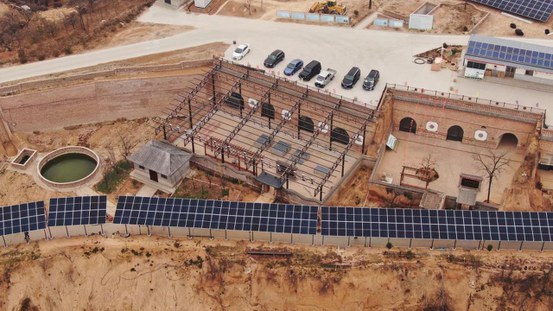Demonstrations of a New Building Power System Showed Potential for Zero Emissions

A Demonstration Project in Zhuangshang Village, Ruicheng County, Shanxi Province.
Photo Courtesy of Nanjing Golden Cooperate DC Power Distribution Technology Co., Ltd.
The Building Energy Conservation Center at Tsinghua University and Energy Foundation China (EF China) held a symposium on March 28, 2022, presenting cases of demonstration projects for the new “PEDF” building power system—a combined photovoltaics, energy storage, high efficiency direct current power, and flexible load system.
The PEDF system has been included in the recent national planning documents such as the Action Plan for Carbon Peaking Before 2030, the Action Plan for Innovation-Driven Development of the Intelligent Photovoltaic Industry, and the 14th Five-Year Plan for Green Buildings. As an emerging integrated solution that can help achieve carbon neutrality, PEDF has attracted widespread attention. This online symposium was featured as an event of Tsinghua’s 18th annual academic week on Building Energy Conservation, attracting more than 5,000 streaming viewers. Academician Yi JIANG of Tsinghua University and Director Zhigao WANG of the Low Carbon Cities Program of EF China delivered welcoming speeches.
Professor JIANG said that PEDF buildings would potentially bring about a revolution of the entire energy system. “Against the backdrop of the shift from fossil fuels toward zero carbon energy, a major challenge lies in the mismatch between power supply and utilization due to the structural changes of energy mix. Buildings are a major reason of a fluctuating load on the power demand of cities. PEDF buildings have been created to address this issue, in the hopes of achieving the zero carbon target through flexible power load changes,” said him.
At the symposium, representatives from the organizations implementing PEDF building demonstration projects introduced to industry experts, scholars, and other stakeholders the progress made in Shenzhen’s Building in the Future; a village-level demonstration in Ruicheng County, Shanxi Province; a demonstration project in Tibet; Huzhou’s Luneng Mansion; as well as cases of PEDF as a solution for facilitating urban renewal. The successful implementation of PEDF demonstration projects is critical in attesting this new building energy system. Participants of this symposium discussed their application in urban and rural areas, for newly built and existing buildings, and with functions of residential or public buildings.
In the future, EF China will continue to support PEDF studies and pilot demonstration projects and hopes to facilitate the broader application of such new solutions, the larger-scale utilization of renewables, and the early achievement of China’s carbon goals.




